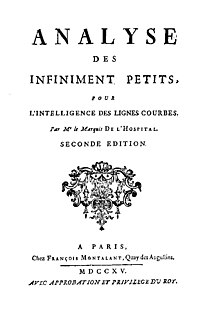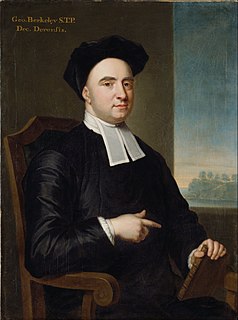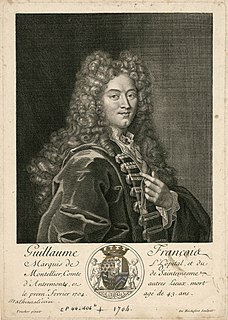 W
WAnalyse des Infiniment Petits pour l'Intelligence des Lignes Courbes, 1696, is the first textbook published on the infinitesimal calculus of Leibniz. It was written by the French mathematician Guillaume de l'Hôpital, and treated only the subject of differential calculus. Two volumes treating the differential and integral calculus, respectively, had been authored by Johann Bernoulli in 1691–1692, and the latter was published in 1724 to become the first published textbook on the integral calculus.
 W
WGeorge Berkeley – known as Bishop Berkeley – was an Irish philosopher whose primary achievement was the advancement of a theory he called "immaterialism". This theory denies the existence of material substance and instead contends that familiar objects like tables and chairs are ideas perceived by the minds and, as a result, cannot exist without being perceived. Berkeley is also known for his critique of abstraction, an important premise in his argument for immaterialism.
 W
WJohann Bernoulli was a Swiss mathematician and was one of the many prominent mathematicians in the Bernoulli family. He is known for his contributions to infinitesimal calculus and educating Leonhard Euler in the pupil's youth.
 W
WLazare Nicolas Marguerite, Count Carnot was a French mathematician, physicist and politician. He was known as the "Organizer of Victory" in the French Revolutionary Wars and Napoleonic Wars.
 W
WBaron Augustin-Louis Cauchy was a French mathematician, engineer, and physicist who made pioneering contributions to several branches of mathematics, including mathematical analysis and continuum mechanics. He was one of the first to state and rigorously prove theorems of calculus, rejecting the heuristic principle of the generality of algebra of earlier authors. He almost singlehandedly founded complex analysis and the study of permutation groups in abstract algebra.
 W
WIn geometry, Cavalieri's principle, a modern implementation of the method of indivisibles, named after Bonaventura Cavalieri, is as follows:2-dimensional case: Suppose two regions in a plane are included between two parallel lines in that plane. If every line parallel to these two lines intersects both regions in line segments of equal length, then the two regions have equal areas. 3-dimensional case: Suppose two regions in three-space (solids) are included between two parallel planes. If every plane parallel to these two planes intersects both regions in cross-sections of equal area, then the two regions have equal volumes.
 W
WCours d'Analyse de l’École Royale Polytechnique; I.re Partie. Analyse algébrique is a seminal textbook in infinitesimal calculus published by Augustin-Louis Cauchy in 1821. The article follows the translation by Bradley and Sandifer in describing its contents.
 W
WPierre de Fermat was a French lawyer at the Parlement of Toulouse, France, and a mathematician who is given credit for early developments that led to infinitesimal calculus, including his technique of adequality. In particular, he is recognized for his discovery of an original method of finding the greatest and the smallest ordinates of curved lines, which is analogous to that of differential calculus, then unknown, and his research into number theory. He made notable contributions to analytic geometry, probability, and optics. He is best known for his Fermat's principle for light propagation and his Fermat's Last Theorem in number theory, which he described in a note at the margin of a copy of Diophantus' Arithmetica.
 W
WA fluent is a time-varying quantity or variable. The term was used by Isaac Newton in his early calculus to describe his form of a function. The concept was introduced by Newton in 1665 and detailed in his mathematical treatise, Method of Fluxions. Newton described any variable that changed its value as a fluent – for example, the velocity of a ball thrown in the air. The derivative of a fluent is known as a fluxion, the main focus of Newton's calculus. A fluent can be found from its corresponding fluxion through integration.
 W
WA fluxion is the instantaneous rate of change, or gradient, of a fluent at a given point. Fluxions were introduced by Isaac Newton to describe his form of a time derivative. Newton introduced the concept in 1665 and detailed them in his mathematical treatise, Method of Fluxions. Fluxions and fluents made up Newton's early calculus.
 W
WIn mathematics, infinitesimals or infinitesimal numbers are quantities that are closer to zero than any standard real number, but are not zero. They do not exist in the standard real number system, but do exist in many other number systems, such as the surreal numbers and hyperreal numbers, which can be thought of as the real numbers augmented with a system of infinitesimal quantities, as well as infinite quantities, which are the reciprocals of the infinitesimals.
 W
WThe calculus controversy was an argument between the mathematicians Isaac Newton and Gottfried Wilhelm Leibniz over who had first invented calculus. The question was a major intellectual controversy, which began simmering in 1699 and broke out in full force in 1711. Leibniz had published his work first, but Newton's supporters accused Leibniz of plagiarizing Newton's unpublished ideas. Leibniz died in disfavor in 1716 after his patron, the Elector Georg Ludwig of Hanover, became King George I of Great Britain in 1714. The modern consensus is that the two men developed their ideas independently.
 W
WGottfried Wilhelm (von) Leibniz was a prominent German polymath and one of the most important logicians, mathematicians and natural philosophers of the Enlightenment. As a representative of the seventeenth-century tradition of rationalism, Leibniz developed, as his most prominent accomplishment, the ideas of differential and integral calculus, independently of Isaac Newton's contemporaneous developments. Mathematical works have consistently favored Leibniz's notation as the conventional expression of calculus. It was only in the 20th century that Leibniz's law of continuity and transcendental law of homogeneity found mathematical implementation. He became one of the most prolific inventors in the field of mechanical calculators. While working on adding automatic multiplication and division to Pascal's calculator, he was the first to describe a pinwheel calculator in 1685 and invented the Leibniz wheel, used in the arithmometer, the first mass-produced mechanical calculator. He also refined the binary number system, which is the foundation of nearly all digital computers, including the Von Neumann machine, which is the standard design paradigm, or "computer architecture", followed from the second half of the 20th century, and into the 21st.
 W
WIn calculus, Leibniz's notation, named in honor of the 17th-century German philosopher and mathematician Gottfried Wilhelm Leibniz, uses the symbols dx and dy to represent infinitely small increments of x and y, respectively, just as Δx and Δy represent finite increments of x and y, respectively.
 W
WGuillaume François Antoine, Marquis de l'Hôpital, also known as Guillaume-François-Antoine Marquis de l'Hôpital, Marquis de Sainte-Mesme, Comte d'Entremont, and Seigneur d'Ouques-la-Chaise, was a French mathematician. His name is firmly associated with l'Hôpital's rule for calculating limits involving indeterminate forms 0/0 and ∞/∞. Although the rule did not originate with l'Hôpital, it appeared in print for the first time in his 1696 treatise on the infinitesimal calculus, entitled Analyse des Infiniment Petits pour l'Intelligence des Lignes Courbes. This book was a first systematic exposition of differential calculus. Several editions and translations to other languages were published and it became a model for subsequent treatments of calculus.
 W
WSir Isaac Newton was an English mathematician, physicist, astronomer, theologian, and author who is widely recognised as one of the most influential scientists of all time and as a key figure in the scientific revolution. His book Philosophiæ Naturalis Principia Mathematica, first published in 1687, established classical mechanics. Newton also made seminal contributions to optics, and shares credit with Gottfried Wilhelm Leibniz for developing the infinitesimal calculus.
 W
WMichel Rolle was a French mathematician. He is best known for Rolle's theorem (1691). He is also the co-inventor in Europe of Gaussian elimination (1690).
 W
WJohn Wallis was an English clergyman and mathematician who is given partial credit for the development of infinitesimal calculus. Between 1643 and 1689 he served as chief cryptographer for Parliament and, later, the royal court. He is credited with introducing the symbol ∞ to represent the concept of infinity. He similarly used 1/∞ for an infinitesimal. John Wallis was a contemporary of Newton and one of the greatest intellectuals of the early renaissance of mathematics.